NETHERLANDS
Economy

Economy
Cities in NETHERLANDS
| Amsterdam | Eindhoven | Maastricht |
| Rotterdam | The hague |
Economy
General
 Polder model consultation between employers, employees and government in the NetherlandsPhoto: Rob Bogaerts / Anefo in the public domain
Polder model consultation between employers, employees and government in the NetherlandsPhoto: Rob Bogaerts / Anefo in the public domain
The Netherlands has a free market economy in which the government can intervene in the economic process by means of legislation and regulations and there is talk of a managed economy.
The Second World War significantly changed the Dutch economy due to, among other things, strongly changed circumstances such as strong population growth and the loss of the colonies. In a relatively short period of time, the Netherlands has developed from a predominantly agricultural country into an industrial, internationally oriented nation. The Dutch economy is generally stable, which is partly maintained by a structural, intensive consultation between government, industry and trade unions, the so-called polder model. All these factors have made the Netherlands one of the largest economies in the world.
In 2017, agriculture and fishing contributed 1.6% of the gross national product, industry for 17.9% and the remaining 80.2% was accounted for by the services sector.
The large natural gas reserves have traditionally been of great importance to the Dutch economy, partly because of the income from exports. Due to the earthquakes in Groningen, this source of income is diminishing. Major European rivers such as the Rhine, Maas and Scheldt play a major role for the Netherlands as a hub in European transit traffic to, for example, the German Ruhr area, making Rotterdam the largest port in the world for many years. Schiphol Airport is also an important driver of the Dutch economy and the head offices of many multinationals are located in the Netherlands, including Shell, Unilever and Philips.
The Dutch economy benefited from the economic boom in the 1980s and 1990s; in the period from 1990 to 2008, economic growth averaged around 2%. This period of prosperity was brought to an end by the credit crisis. In 2013 the economy contracted by -1%. The official unemployment rate in 2017 was 4.9% of the labor force, which puts the Netherlands well below the EU average. The GDP of the Dutch is $53,900 (2017).
Agriculture and horticulture, animal husbandry
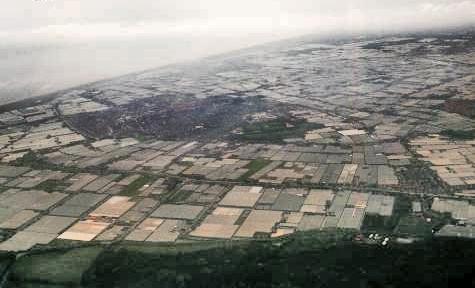 Greenhouses in the Westland, NetherlandPhoto: Rob Hooft CC 3.0 Unported no chnges made
Greenhouses in the Westland, NetherlandPhoto: Rob Hooft CC 3.0 Unported no chnges made
The share of agriculture and horticulture in the total working population decreased from approx. 17% in 1950 to around 1% in 2017 and the share in the national income decreased from 14.4 to 1.6% during this period. Despite this, the Netherlands is still one of the largest agricultural exporters in the world. Many agricultural products are exported with Germany as the main buyer, followed by the other countries of the European Union.
More than 60% of the Dutch soil is in agricultural use. Thanks to the intensification of land use and the higher yields per hectare, the total production volume of Dutch agriculture and horticulture has increased enormously. This production expansion could only take place through a strong increase in the amount of production resources, such as fertilizer and balanced animal feed.
Good agricultural education and practical information have also contributed greatly to the increase in productivity.
The agricultural activities are spread all over the country. An important part of the arable farming is found on the sea clay soils in the north and southwest of the country and also in the IJsselmeer polders. Although the amount of arable land is declining, the yields per hectare have risen sharply in recent decades. Important products are potatoes, wheat, sugar beets and especially silage maize, which is used as animal feed. The Dutch seed potatoes are exported all over the world.
Intensive livestock farming or bio-industry (pig farming, poultry farming and calf farming) is largely concentrated on the sandy soils in Gelderland, Noord-Brabant and Limburg. This sector threatens the environment with its gigantic manure surplus. Dairy farming is found all over the country, but specific pasture areas are Friesland and North and South Holland.
Horticulture is the largest agricultural sector in the Netherlands in terms of production volume. For example, the Netherlands is the largest exporter of flowers and flower bulbs in the world. Other important horticultural products are cucumbers, tomatoes, lettuce, mushrooms, fruit, peppers and potted plants.
Greenhouse horticulture, which is by far the most important part of Dutch horticulture from an economic point of view, is largely concentrated in a few large centers, including those in the southwest of South Holland being the most important. These companies often focus on one or a few crops.
Attention to the environment is becoming increasingly important and more and more farmers are striving for sustainable forms of agriculture that save the environment. For example, people are increasingly switching to biological crop protection to prevent and control pests and diseases. Research into less disease-sensitive crops is also important.
Forestry
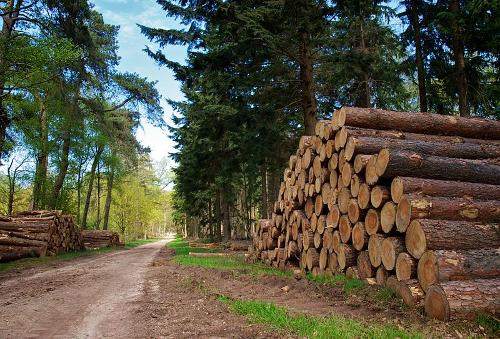 Forestry NetherlandsPhoto: E Dronkert CC 2.0 Generic no changes made
Forestry NetherlandsPhoto: E Dronkert CC 2.0 Generic no changes made
The Netherlands is a little wooded country. In 2017, only 8% (approx. 300,000 ha) of the surface was forested. The forest consists of approx. 60% coniferous wood. The province with the largest area of forest is Gelderland, followed by Noord-Brabant and Overijssel.
Forest mainly occurs on the worse soils. However, there is a tendency to plant forest on better soils as well. In addition to being a wood supplier, the forest is important for recreation. Environmental pollution, especially in the form of acidification, is a serious threat to the tree population.
Fishing
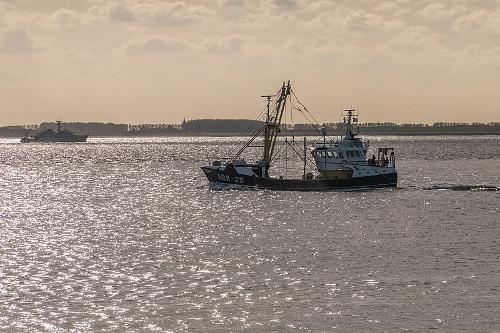 Fishing boat NetherlandsPhoto: Rijkswaterstaat CC 3.0 Unported no changes made
Fishing boat NetherlandsPhoto: Rijkswaterstaat CC 3.0 Unported no changes made
Fishing in the open sea is carried out in the North Sea and its sea basins and in waters beyond (waters around Ireland, Iceland and Newfoundland). A major branch of Dutch professional fisheries is coastal fisheries. In general, fishing is mainly for roundfish, herring and mackerel. The Netherlands has a very modern fleet of cutters and large trawlers. The trawlers mainly fish for herring and mackerel. The small cutters fish for plaice, cod, haddock, whiting and shrimps.
The economically most important group in that year was formed by the flatfish, followed by the round fish and crustaceans and molluscs such as oysters, shrimps and mussels. Mussels, oysters and cockles are mainly cultivated in the waters of Zeeland and the Wadden Sea. Inland fisheries are of little economic importance, apart from eel fishing. The main fishing ports are IJmuiden, Scheveningen and Urk.
Due to the sharp decline of certain fish species, the European Union has been setting annual catch quotas since 1983. The number of days on which fishing is allowed is also sometimes limited.
Industry
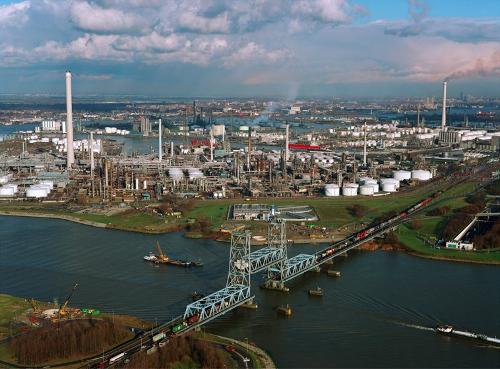 Petrochemical industry Botlek area, NetherlandsPhoto: Michiel1972 at Dutch Wikipedia in the public domain no changes made
Petrochemical industry Botlek area, NetherlandsPhoto: Michiel1972 at Dutch Wikipedia in the public domain no changes made
At the end of the 19th century, the Netherlands became an industrial country when the share of employment in industry was greater than in agriculture. Before that, there were mainly industrial activities in the south of the Netherlands. This mainly concerned the clothing, textile and footwear industry.
In the period up to the First World War, the industry experienced strong growth, especially in the metal industry and the graphics, chemical and paper industries.
The industries mentioned above, as well as construction and the food industry, continued to provide the most employment for the time being. More and more factories were also built in Rotterdam, Amsterdam, the south and in Twente, the center of the cotton industry. This made the cottage industry less and less important.
Not much changed until World War II. The industry continued to develop mainly in the west of the country and the dairy industry and slaughterhouses emerged as an export industry. The chemical industry, later of great importance, was not much of a value at that time. Yet the textile industry, which is important for the Netherlands, was already threatened by the development of synthetic fibers abroad.
After the Second World War, the economic development of the Netherlands was dominated by reconstruction and in its wake industrial industry grew very quickly. Construction and infrastructure were of course very important, but job creation by increasing exports also had a high priority. Real growth industries became the electrical, basic metal and chemical industries.
After the establishment of the European Economic Community (EEC, 1958), now the European Union (EU), the growth of the industry accelerated, among other things due to the strongly increasing exports, but the discovery of natural gas also had a stimulating effect. The petrochemical industry was the fastest growing, especially in the period 1963-1973. The low energy prices and the possibility to settle in the Rijnmond area led to a lot of foreign investment.
On the other hand, the traditional labor-intensive industries were struggling due to the large wage increases, causing companies to increasingly move to so-called low-wage countries.
At the moment, the Dutch industry focuses mainly on primary products and semi-finished products and is characterized by its international orientation, both in terms of sales abroad and the spread of production sites and cooperation with foreign companies. The main sectors are the highly automated chemical food processing industry and the metal processing industry. The graphics and electrical engineering industries are also well developed.
Since the late 1960s, the adverse effects of industrial growth have also attracted worldwide attention, including pollution of the environment, the depletion of our protective ozone layer and the depletion of natural resources. After the oil crisis in 1973, with its sharply rising prices, Dutch industry was hit hard and growth slowed. Owning natural gas still provided an important advantage over other countries.
From 1982 on, government policy increasingly focused on export growth. The companies also invested more and more abroad, causing the desired expansion of the industrial base to stagnate. The Dutch industry in the 1980s did not innovate, only the existing production processes were improved. As a result, average growth continued to increase but lagged behind in comparison to other industries.
Mining and energy supply
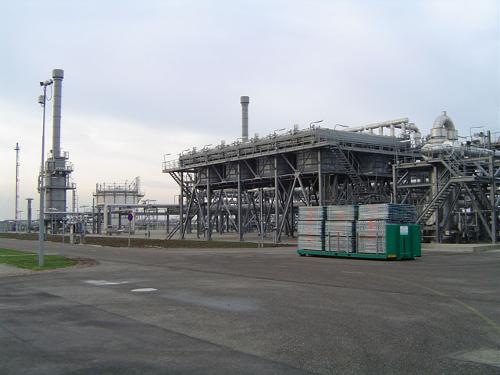 NAM underground gas storage field at Norg / Langelo, NetherlandsPhoto: Thijs.nl CC 3.0 Unported no changes made
NAM underground gas storage field at Norg / Langelo, NetherlandsPhoto: Thijs.nl CC 3.0 Unported no changes made
Only minerals such as sand, clay, gravel, marl and lime can be found on the surface. Deeper layers contain salt, oil, natural gas and coal. Salt is extracted at Hengelo by spraying water down and pumping up the brine. Coal was mined underground in the province of Limburg until 1975, but the discovery of natural gas and the low price of foreign coal prompted the mines to be closed. There is still 1,000 billion tons of coal in the subsurface, but only 4% of it can be extracted by conventional methods.
On the mainland, the Netherlands has two oil fields in Schoonebeek and the west of the Netherlands, and one oil field on the continental shelf. The natural gas field at Slochteren was discovered in 1959, but it was not until 1967 that the field came into production.
Until the Second World War, the Netherlands depended mainly on resources such as coal and wind for its energy consumption. After the war, until 1967, oil from abroad became very important for energy supply. After that, the natural gas field at Slochteren was put into use and the share of natural gas for the energy supply increased rapidly. In fact, enough natural gas was extracted for export and the Netherlands soon became the largest natural gas producer in Western Europe. Due to the reduction of fossil fuels in 2017, the Netherlands is at the start of an energy transition.
Trade and traffic
Trade
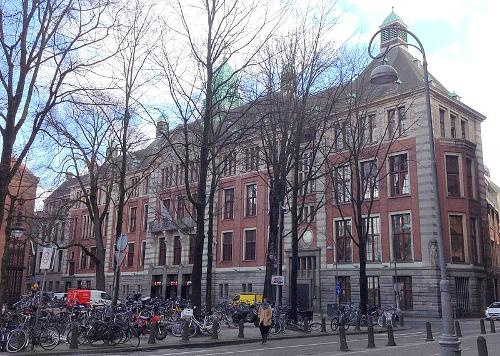 Stockmarket AmsterdamPhoto: Zandcee CC 4.0 International no changes made
Stockmarket AmsterdamPhoto: Zandcee CC 4.0 International no changes made
The domestic market in the Netherlands is only small, which is why many companies focus on markets abroad. The favorable geographic location in Western Europe is also extremely suitable for international trade, both on water, in the air, and by road.
The main import products are (electrical) machines, manufactured goods, food, fuel and clothing. Total value of imports was $ 453.8 billion (2017).
The most important export products are foodstuffs, chemical products, (semi) manufactures, (electrical) machines, flowers and petroleum products. Total value of exports was $ 840 billion (2017).
Traditionally, the trade balance has a surplus, as does the current account balance of the balance of payments. The main sales market for the Netherlands is Europe, especially the countries of the European Community. Important trading partners in other parts of the world are the United States, China, Japan and South Africa.
Traffic
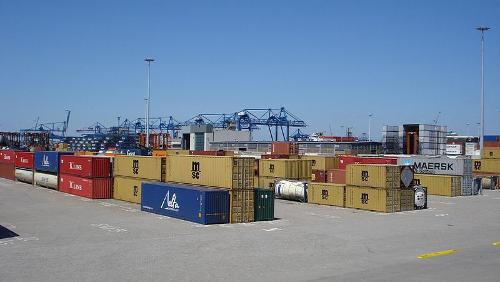 Eemhaven RotterdamPhoto: WikiFritz in the public domain
Eemhaven RotterdamPhoto: WikiFritz in the public domain
From an economic point of view, traffic plays a very important role due to its location at the mouths of rivers such as the Rhine, Maas and Scheldt and the highly industrialized hinterland (including the Ruhr area). As a result, the Netherlands has developed as the gateway to Europe and due to its central location, the Netherlands has also become the location of many international companies.
The Netherlands has an extensive and high-quality (motor) road network for this purpose, which the Dutch transport sector can benefit from. This sector controls an important part of the European transport market.
The many inland and cross-border waterways are also of great importance for freight transport.
The Dutch Railways are mainly important for domestic passenger transport, although more and more goods are also transported by rail.
Domestic air traffic plays only a minor role of significance for the Dutch economy. KLM is the national airline that has an extensive international air network. KLM has merged with Air France. Schiphol is one of the largest international airports in the world and is considered one of the engines of the economy.
The merchant fleet is declining in both size and economic significance, but Rotterdam remains one of the largest seaports in the world for cargo transhipment and Amsterdam has also developed into a significant transhipment location. Every year, tens of millions of tons of goods are delivered to the port of Rotterdam. Container transport in particular nowadays determines the face of the port. In addition to Rotterdam and Amsterdam, the seaports of Velsen / IJmuiden, Delfzijl, Eemshaven, Vlissingen, Terneuzen and Vlaardingen are also important.
Sources
Haafkens, M. / Nederland
Gottmer
Harmans, G.L.M. / Nederland
Van Reemst
Metze, M. / De staat van Nederland
SUN
Ver Berkmoes, R. / Netherlands
Lonely Planet
CIA - World Factbook
BBC - Country Profiles
Last updated November 2025Copyright: Team The World of Info